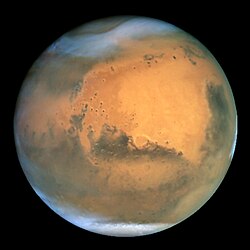Cape Verde
- Denna artikel handlar om kratern Cape Verde i planeten Mars. För staten Kap Verde, se Kap Verde.

Cape Verde är en stor udde vid kanten av Victoriakratern i Meridiani Planum, Mars. Mars Exploration Rover Opportunity försökte nå toppen av denna bildning i oktober 2006 för att fotografera Victoriakratern.[1]
Källor
| ||||||||||||||||||||||||||||||||||||||||||||||||||||||||
Media som används på denna webbplats
NASA's Hubble Space Telescope took the picture of Mars on June 26, 2001, when Mars was approximately 68 million kilometers (43 million miles) from Earth — the closest Mars has ever been to Earth since 1988. Hubble can see details as small as 16 kilometers (10 miles) across. The colors have been carefully balanced to give a realistic view of Mars' hues as they might appear through a telescope. Especially striking is the large amount of seasonal dust storm activity seen in this image. One large storm system is churning high above the northern polar cap (top of image), and a smaller dust storm cloud can be seen nearby. Another large dust storm is spilling out of the giant Hellas impact basin in the Southern Hemisphere (lower right).
This view of Victoria crater is looking north from "Duck Bay" towards the dramatic promontory called "Cape Verde." The dramatic cliff of layered rocks is about 50 meters (about 165 feet) away from the rover and is about 6 meters (about 20 feet) tall. The taller promontory beyond that is about 100 meters (about 325 feet) away, and the vista beyond that extends away for more than 400 meters (about 1300 feet) into the distance. This is an approximately true color rendering of images taken by the panoramic camera (Pancam) on NASA's Mars Exploration Rover Opportunity during the rover's 952nd sol, or Martian day, (Sept. 28, 2006) using the camera's 750-nanometer, 530-nanometer and 430-nanometer filters.


